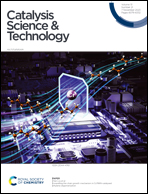Cu–Fe bimetallic MOF enhances the selectivity of photocatalytic CO2 reduction toward CO production†
Abstract
The rational design of multi-ligand bimetallic MOFs with a monomolecular structure is a very effective way to study product selectivity of the photocatalytic CO2 reduction reaction (CO2RR) using MOFs-based catalysts. Herein, a new Cu–Fe bimetallic MOF material, namely Cu-MOF–Fcdc-20% (Fcdc = 1,1′-ferrocenedicarboxylic acid), was constructed by a multi-ligand strategy to improve the selectivity of photocatalytic CO2 reduction toward CO production. Specifically, the Cu-MOF based on H3NTB (4,4′,4′′-nitrilotribenzoic acid) and the phen ligand (1,10-phenanthroline) could catalyze CO2 to CO, but with relatively low selectivity. After the introduction of the Fcdc ligand, the resulting Cu-MOF–Fcdc-20% displayed not only enhanced CO selectivity but also improved efficiency for CO2RR. Cu-MOF–Fcdc-20% exhibited a higher CO selectivity of 97.07% and a CO yield of 8.61 μmol g−1 h−1, which is about 5.48 times higher than that exhibited by Cu-MOF (1.57 μmol g−1 h−1, 81.35%). In situ FT-IR, EPR, and other experimental characterizations were further performed to investigate the intrinsic mechanism of the photocatalytic CO2 reduction process. The in situ FT-IR experimental data show that Cu-MOF–Fcdc-20% can effectively accelerate the rate-limiting step  , which in turn improves the rate and selectivity of CO2 conversion to CO. This work demonstrates that the rational design of the Cu–Fe bimetallic MOF structure can effectively improve the catalytic selectivity of the photocatalytic CO2 reduction reaction, offering a new way of designing highly selective MOF photocatalysts.
, which in turn improves the rate and selectivity of CO2 conversion to CO. This work demonstrates that the rational design of the Cu–Fe bimetallic MOF structure can effectively improve the catalytic selectivity of the photocatalytic CO2 reduction reaction, offering a new way of designing highly selective MOF photocatalysts.



 Please wait while we load your content...
Please wait while we load your content...